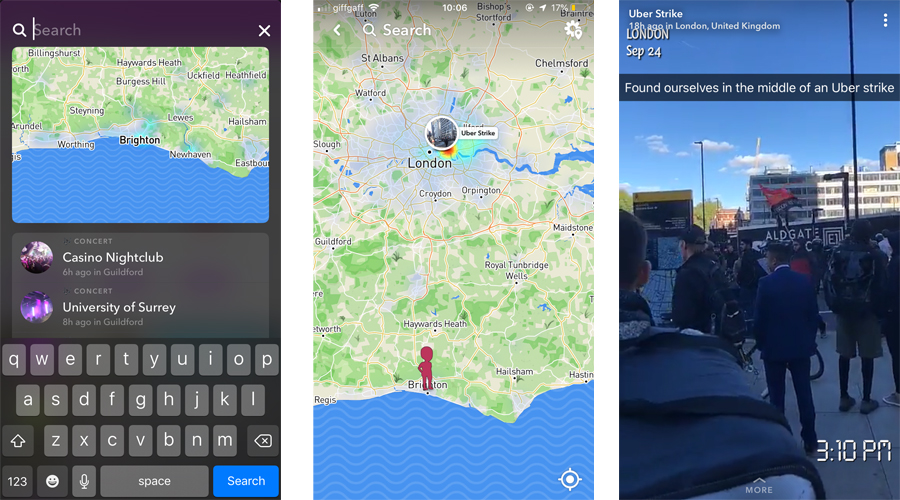
When a Chevron oil refinery in El Segundo, Los Angeles, caught fire on 17 September, Snapchat users were the first to break the event on social media — within two minutes of the occurrence.
SAM, a social media AI engine, also found it was not for another three minutes that Twitter made any mention of the outbreak.
“Contrary to what many might think of Snapchat being a platform built entirely for selfie filters and effects, it has a lot to offer to newsrooms,” said James Neufeld, CEO and founder, SAM.
“Because every public snap has geolocation, it makes finding credible eyewitness content easier than most platforms – it is very live and in the moment. You are either at the scene of the event or you’re not."
SAM works with Snapchat and Twitter to turn snaps, tweets, photos and videos into actionable data by using algorithms. It is proving a very fast way for journalists to keep their finger on the pulse around them, helping to pinpoint and verify breaking news events.
So with three billion snaps taken everyday, should newsrooms should pay more attention to Snapchat to get ahead of stories?
Many newsrooms have already looked at Snapchat for a range of uses, including referendum coverage for C4, as a content management system for Hindustan Times, and reaching younger audiences by The Telegraph.
Now it seems covering breaking news is within the realms of possibilities as a newsgathering tool according to Neufeld, and also as a resource to corroborate reports from other social media platforms.
Adam Parker, digital news editor, Sky News said that Snapchat has proved useful as a secondary source for follow-up video and image content – but it has its drawbacks as most Snapchat users are private.
"It's brilliant for the where and when – which are the big two – but any time we have used video from snapchat using snap maps, we haven't been able to communicate with the uploader.
"So we have used it without permission - we think that's okay and we do it - but it's a grey area where we would legally like to ask someone if we can use their content first," he said.
In April 2017, Sky ran the breaking news story of the Paris shooting leading with a Snapchat video, which to this day Parker does not know who the original uploader is. Later in August, they used snap maps to gain content for the story on a BMW-ram attack on soldiers.
Despite learning that Snapchat broke the Chevron fire faster than Twitter, Parker said Twitter remains his 'first port of call'. He outlined that Snapchat would need to do more to change the way he works.
"Snapchat in a way hasn't done us that many favours, it could be a lot more useful than it is," he said. "If any time someone posts a snap they were asked if they were willing to make it public, that would mean there would be many more snaps available and be a lot more useful for journalists."
The Chevron fire is not the only example of Snapchat getting the jump on Twitter though. The Mandarin Hotel fire in London (6 June) and the steam pipe explosion in New York (19 July) show similar patterns and Neufeld reasons that people may be using Snapchat simply because it is a very accessible tool.
“I think there is a lot to be said for how Snapchat is optimised for breaking news as a camera-first experience," Neufeld said.
“Snapchat sees itself as a camera company, I think newsrooms can view that as the largest community for real-time photography and videography – it is viewing the world through the lens of other people’s cameras.”
How you can give it a go?

By enabling their location on the app, Snapchat users can start using snap maps - a great, free tool for journalists to make the most of too. Alternatively, a web version is also available.
This will show you heatmaps indicating concentrated areas of 'snapping', suggesting something is happening of local significance – simply click in the highlighted areas to see the nearby snaps, but this can be hit-and-miss for newsrooms.
For confirmed major events, the map will circle and title saying what is happening and where, linking you to on-the-ground footage from other users.
Interested in AI? What about social media storytelling? Then come along to our Newsrewired conference on 7 November where we will be discussing how to implement both of these in the newsroom.
Free daily newsletter
If you like our news and feature articles, you can sign up to receive our free daily (Mon-Fri) email newsletter (mobile friendly).
Related articles
- Audiences, AI and audio apps: five talking points from Perugia
- How a Greenlandic publisher uses its own AI translator to boost subscriptions
- How NRK uses AI-generated summaries to boost younger readers’ engagement
- Four biases that leave under-represented groups out of GenAI-assisted journalism
- New blockchain verification tool to help fight the use of deep fakes in elections









